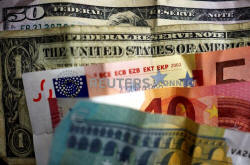Euro falls to three-week lows as U.S. yields climb
 Send a link to a friend
Send a link to a friend
 [January 11, 2021] By
Saikat Chatterjee [January 11, 2021] By
Saikat Chatterjee
LONDON (Reuters) - The dollar gained on
Monday as widening U.S. Treasury yields and expectations of more fiscal
stimulus lifted it for a third consecutive day, with the euro falling to
a three-week low.
President-elect Joe Biden, who takes office on Jan. 20 with Democrats
able to control both houses of Congress, has promised "trillions" in
extra pandemic-relief spending.
Ordinarily, the extra spending plans would force investors to worry
about rising inflation and its detrimental effect on the U.S. dollar in
a weak economy, but the currency has been supported in recent weeks
thanks to rising U.S. yields.
At 103 basis points, the spread between the three-month and 10-year U.S.
debt is at its steepest since late March and is approaching the 2020
highs of 123 bps. The 10-year yield of 1.10% is the highest since March
19, while the 10-year TIPS inflation break-even inflation rate of 2.07%
is the highest since November 2018.

As a result, the euro fell 0.5% to $1.2155, its lowest since Dec. 21,
down nearly 2% from a high of $1.2349 last week.
"It is hardly surprising that the recent acceleration in real U.S.
yields has reminded the FX markets to end its focus on inflation and to
assume a more comprehensive approach in its dollar valuation,"
Commerzbank strategists said.
"That means: things are not looking so bad for the dollar at present
that EUR-USD levels of 1.2350 and above would currently be justified."
The nominal yield on benchmark 10-year U.S. debt is up more than 20
basis points to 1.1187% this year, helping the dollar to rise to a
one-month high of 104.20 against the Japanese yen.
[to top of second column] |

U.S. dollar and Euro
bank notes are photographed in Frankfurt, Germany, in this
illustration picture taken May 7, 2017. May 7, 2017. REUTERS/Kai
Pfaffenbach/Illustration/File Photo

Morgan Stanley recommended a neutral view on the dollar and closed a
dollar-bearish trade versus the euro and the Canadian dollar, according to a
note published last week.
The dollar index has lost roughly 12% since a three-year peak in March. It is
now more than 1.3% above the almost- three-year low it hit last week. It rose
0.1% to 90.418 on Monday.
"Everyone's asking whether this changes the weaker dollar narrative - that's why
I think we're getting a bit of a continuation of what we're seeing on Thursday
and Friday," said National Australia Bank's head of FX strategy, Ray Attrill.
That has also prompted some investors to trim their bearish bets versus the
dollar with net short bets on the dollar versus the euro declining to $21
billion, compared with $24 billion two weeks earlier, according to latest
positioning data.
Elsewhere, the hitherto soaring Australian dollar fell nearly 1% to $0.7693,
unmoved by another solid month of local retail sales. The dollar also rose 0.2%
to 6.4864 yuan after weak factory gate prices in China.
(Reporting by Saikat Chatterjee; editing by Kirsten Donovan, Larry King)
[© 2021 Thomson Reuters. All rights
reserved.] Copyright 2021 Reuters. All rights reserved. This material may not be published,
broadcast, rewritten or redistributed.
Thompson Reuters is solely responsible for this content.
 |